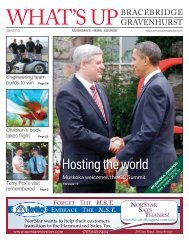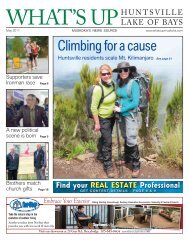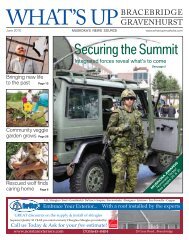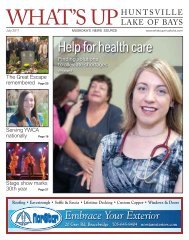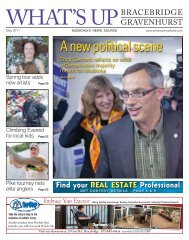Whats Up Magazine Huntsville Lake of Bays - What's Up Muskoka
Whats Up Magazine Huntsville Lake of Bays - What's Up Muskoka
Whats Up Magazine Huntsville Lake of Bays - What's Up Muskoka
You also want an ePaper? Increase the reach of your titles
YUMPU automatically turns print PDFs into web optimized ePapers that Google loves.
<strong>Muskoka</strong>’s nursing shortage<br />
Nurses Dorothea Tait and Jan Venturelli monitor some equipment in the obstetrics department at the South <strong>Muskoka</strong> Memorial Hospital Site.<br />
By Sandy Lockhart<br />
<strong>Muskoka</strong> has a shortage <strong>of</strong> nurses and it’s only going to get worse<br />
in the next five to 10 years.<br />
“There is absolutely a need in the community,” says Jean<br />
Broere, project manager <strong>of</strong> <strong>Muskoka</strong> Cares. According to statistics<br />
compiled by <strong>Muskoka</strong> Cares, a collective with interest in<br />
health care, there is a vacancy rate <strong>of</strong> 15 per cent for Registered<br />
Practical Nurses (RPN) and seven per cent for Registered Nurses<br />
(RN) in <strong>Muskoka</strong>.<br />
The overall vacancy for health service<br />
pr<strong>of</strong>essionals in <strong>Muskoka</strong>, according to<br />
the survey was six per cent.<br />
“That is probably average for the<br />
province,” says Broere, but <strong>Muskoka</strong>’s<br />
nursing vacancies were high.<br />
To help deal with this shortage, the<br />
<strong>Muskoka</strong> Cares project applied in<br />
December for $500,000 in funding for a<br />
three-year project to implement several<br />
strategies to recruit and retain health care<br />
staff.<br />
“We need to start working now so we<br />
can fix the problem for the future,” she<br />
says, explaining that some strategies can<br />
be done without funding.<br />
In 2009, <strong>Muskoka</strong> Cares surveyed 23<br />
health care organizations to gather the<br />
vacancy rate and other information to<br />
help <strong>Muskoka</strong> recruit and retain health<br />
care staff.<br />
“We did not include physicians and<br />
family health teams as we already know<br />
there is a shortage <strong>of</strong> physicians,” Broere<br />
says. “We needed to know exactly what<br />
was needed.”<br />
Broere believes recruiting more health<br />
care staff would improve the quality <strong>of</strong><br />
health care.<br />
“If we have enough health care staff to<br />
fill all positions, the workload goes down,<br />
absenteeism improves and people are able<br />
to spend more time with the patients,”<br />
she says. “Now when there is a shortage<br />
<strong>of</strong> staff, they are tired and need a break.”<br />
<strong>Muskoka</strong> Algonquin Healthcare has<br />
17 vacant nursing positions in the hospitals<br />
as <strong>of</strong> January 2010. Robert Hughes,<br />
acting chief human resources <strong>of</strong>ficer for<br />
the hospitals, breaks it down into four<br />
full-time, seven part-time, two temporary<br />
full-time, two part-time and two<br />
casual positions.<br />
Hughes says nurses working in parttime<br />
positions have scheduled part-time<br />
hours but can pick up extra shifts and<br />
calls to work full-time hours.<br />
With the hospital’s debt recovery plan,<br />
some lay<strong>of</strong>fs are planned.<br />
“We hope we are able to mitigate job<br />
loss through our vacancies,” says Hughes,<br />
explaining if nursing positions are cut,<br />
those nurses could move into current<br />
vacancies. “I don’t think we will ever eat<br />
up all our vacancies.”<br />
Bev McFarlane, chief nursing <strong>of</strong>ficer<br />
for <strong>Muskoka</strong> Algonquin Healthcare, says<br />
if the hospital nurses didn’t have to work<br />
so many overtime hours, there would be<br />
less burnout.<br />
“A lot <strong>of</strong> our nurses really have an obligation<br />
to patients and say yes when they<br />
would rather not,” she says <strong>of</strong> them being<br />
called in to work overtime. McFarlane<br />
would like overtime to be the exception,<br />
not the rule. Filling these vacant positions<br />
would also save the hospitals<br />
money, as it would have to pay less overtime.<br />
She says attracting nurses is about<br />
recruitment and retention.<br />
“We don’t want them all to retire at<br />
55,” says McFarlane. “We want their<br />
expertise and knowledge. How do you<br />
structure it so they are able to work past<br />
their first retirement opportunity?”<br />
<strong>Muskoka</strong> Cares is the result <strong>of</strong> eight<br />
organizations with interest in the health<br />
care field in <strong>Muskoka</strong>. When recognizing<br />
the shortage <strong>of</strong> healthcare staff, they<br />
joined together and applied for funding<br />
for a one-year pilot project to look at<br />
<strong>Muskoka</strong>’s situation. The <strong>Muskoka</strong> Cares<br />
Steering Committee is made up <strong>of</strong> representatives<br />
from Georgian College’s<br />
<strong>Muskoka</strong> Campus, <strong>Muskoka</strong> Algonquin<br />
Healthcare Corporation, North Simcoe<br />
<strong>Muskoka</strong> Local Health Integration Network,<br />
North Simcoe <strong>Muskoka</strong> Workforce<br />
Labour Board, Northern Ontario<br />
School <strong>of</strong> Medicine, Nipissing University’s<br />
<strong>Muskoka</strong> Campus, Ontario Ministry<br />
<strong>of</strong> Training, Colleges and Universities<br />
and the District <strong>of</strong> Municipality <strong>of</strong><br />
<strong>Muskoka</strong>.<br />
<strong>Muskoka</strong>’s 23 healthcare organizations<br />
employ 1,326 healthcare employees with<br />
about one third employed in acute care,<br />
one third in nursing homes and one third<br />
in community care and retirement<br />
homes. According to research findings,<br />
half <strong>of</strong> the positions were assisting positions<br />
(personal support workers, guest<br />
attendants, unregulated care providers).<br />
The other half were RNs (27 per cent),<br />
RPNs (13 per cent), allied pr<strong>of</strong>essionals<br />
(10 per cent) and nurse practitioners<br />
(two per cent).<br />
Broere says they found that only 43<br />
per cent <strong>of</strong> the positions were full time,<br />
40 were part time and 17 per cent were<br />
temporary casual. Fifteen per cent <strong>of</strong> the<br />
employees held two or more healthcare<br />
jobs.<br />
While the whole province <strong>of</strong> Ontario<br />
and even all <strong>of</strong> Canada is facing a<br />
growing undersupply <strong>of</strong> healthcare<br />
employees, <strong>Muskoka</strong> will face the prob-<br />
www.whatsupmuskoka.com February 2010 5<br />
Photograph: Don MacTavish



